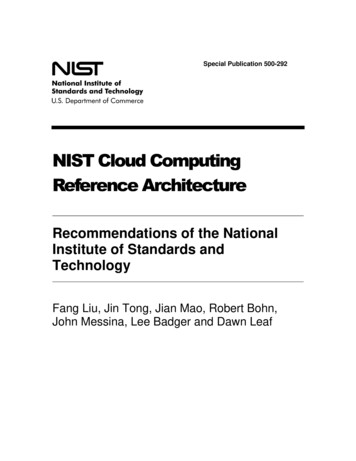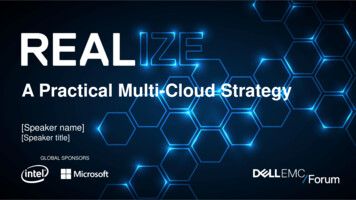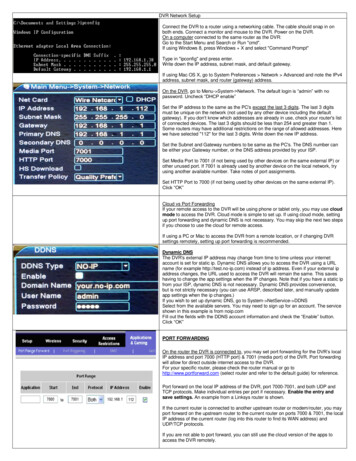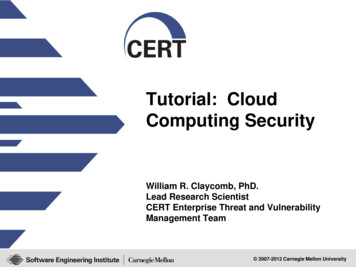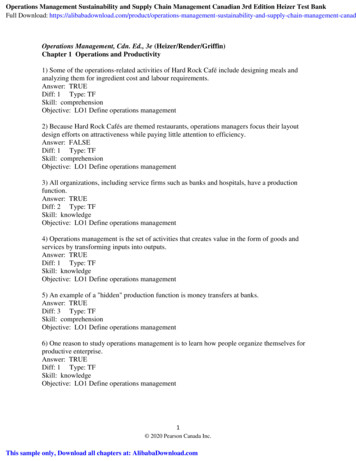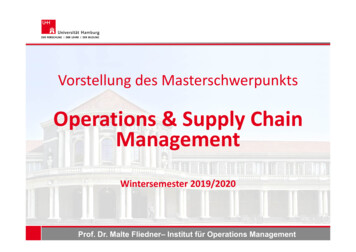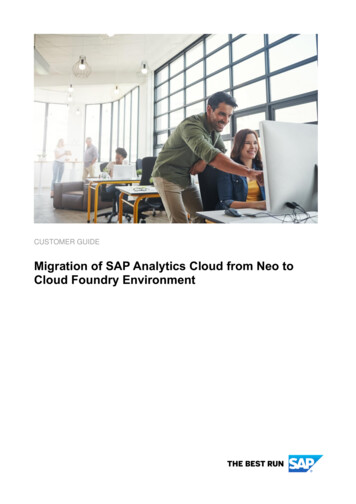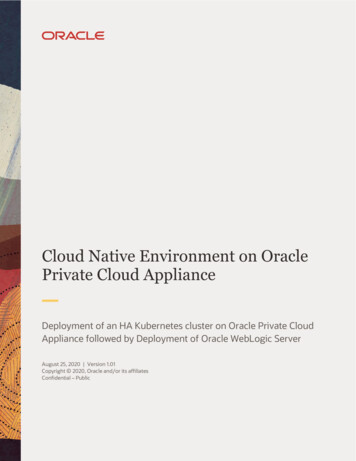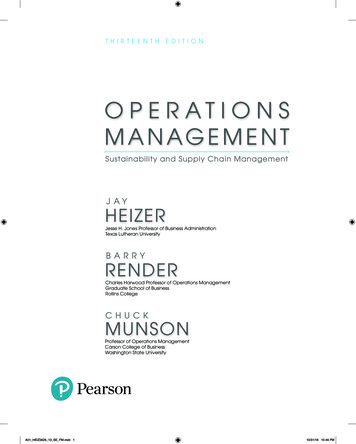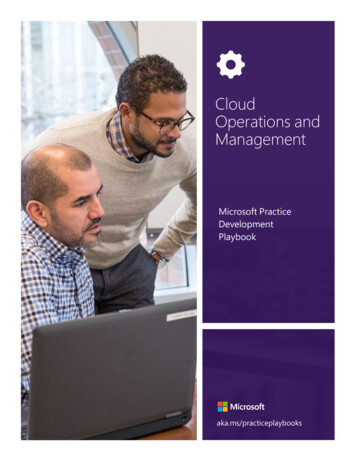
Transcription
ARTIFICIAL INTELLIGENCEPAGE 1CloudOperations andManagementMicrosoft saka.ms/practiceplaybooks
About this PlaybookThis playbook is intended for the business and technical leadership for new and existing Microsoftpartners that are adding a new practice to their business focused on delivery of services for MicrosoftAzure related to Azure operations, security, and management.ObjectivesHow this playbook was madeThe goal of this playbook is to help you accelerate oroptimize your Azure operations and management-focusedpractice.This playbook is part of a series of guidance written byMicrosoft Partner Opsgility, in conjunction with theMicrosoft One Commercial Partner group and 22 othersuccessful Azure partners that have volunteered time toprovide input and best practices to share with the rest ofthe partner community.For the business side, this playbook provides valuableresources for driving new revenue opportunities, strategiesfor marketing, selling, and lead capture, as well as buildingdeeper and longer-term engagements with yourcustomers through potential new service offerings likemanaged services.For the technical side, the playbook offers guidance on anumber of topics that range from the technical skills yourteam will need, to resources that you can use to acceleratelearning as well as an explanation of some of the keyopportunities for technical delivery to focus on as you getstarted and grow your practice.To validate the guidance provided in these playbooks, weconducted a survey of 1,136 global Azure partners withMDC Research. In this survey, we gathered insights on arange of topics, including how partners hire, compensateand train resources; their business model, revenue andprofitability; what practices and services they offer; andwhat skillsets they have in place to support their offers.The results of this survey are provided in-line with theguidance found within this playbook.CON T RI B UT IN G P ART N ER SArtis ConsultingMirabeauAteaNew SignatureAwareCommOpenSistemasBlue MeteoritePC SolutionsDEFTeam SolutionsPerficientDimension DataPlainConceptsEmpiredSlalomEquinixSoftjamFragma Data SystemsSpanishPointHanu SoftwareSQL Services Ltd.Kloud Solutionsaka.ms/practiceplaybooksTheta
AZURE OPERATIONS AND MANAGEMENTPAGE 3Using the playbook effectivelyQuickly read through the playbook to familiarize yourself with the layout and content. Eachsection includes an executive summary and key actions for that specific topic. Review thesesummaries first to decide which areas to focus on. Go over the content several times, ifneeded, then share with your team.TO GET THE MOST VALUE OUT OF THIS PLAYBOOK: Get your team together and discuss which pieces of the strategy each person is responsible for. Share the playbook with your sales, marketing, support, technical, and managed services teams. Leverage the resources available from Microsoft to help maximize your profitability. Share feedback on how we can improve this and other playbooks by ticeplaybooks
AZURE OPERATIONS AND MANAGEMENTPAGE 4Table of ContentsThe Azure Operations and Management Opportunity . 5Managing Azure Subscription Access . 81Define Your Strategy . 7Identity and Access Management (IAM) . 82Executive Summary . 8Security and Networking . 86Identify Target Customers . 9Configuration Management . 92Define Engagement Process . 11Availability and Business Continuity . 94Define Service Offerings .12Compliance and Monitoring . 100Azure Security and Management .13Support and Incident Management . 103Define Your Pricing Strategy . 24Automation and DevOps . 106Calculate Your Azure Practice Costs . 28Continuous Integration / Continuous Deployment . 109Understanding Managed Services . 29Go to Market & Close Deals . 110Accelerate your Managed Service Model .31Executive Summary . 111Understanding Intellectual Property . 38Managed Services Transition . 112Hire & Train . 45Marketing Your Offerings . 113Executive Summary . 46Consultative Selling and Technical Pre-Sales . 114Hire, Build, and Train Your Team . 48Guide: Go-to-Market and Close Deals . 115Job Descriptions for Your Service Delivery Team .51Optimize & Grow . 116Reskilling Your Existing Technical Resources . 63Executive Summary . 117Recruiting Resources . 66Guide: Optimize and Grow . 118Training & Readiness . 67Playbook Summary . 119Competencies and Certifications . 71Additional Resources . 119Operationalize . 76Why Choose Microsoft? . 120Executive Summary . 77Troubleshooting Resources . 123Azure Virtual Datacenter . 78Common Objections . 125Managing Azure Subscription Creation . 79Case Studies.127March 2019aka.ms/practiceplaybooks
AZURE OPERATIONS AND MANAGEMENTPAGE 5The Azure Operations and ManagementOpportunityAs companies embrace the opportunities presented by cloud computing to connect withcustomers and optimize operations, they take on new challenges. One of the biggestchallenges in the adoption of cloud computing is ensuring the customers have the rightskillset to manage the underlying technologies as well as an understanding of how to manageand automate the Microsoft Azure platform.CHANGING BUSINESS NEEDS WITH THE CLOUDIn the new world of digital transformation, technology has become the source of competitive differentiation and customersare asking themselves how their current organizations need to change to adapt into delivering a successful and sustainabledigital business. With IT organizations becoming the primary means of meeting the needs of the business they need toevolve from supporting the business to being a part of the business by delivering value through services hosted in the cloud.As IT organizations become more closely aligned with the business, their roles and responsibilities will also evolve. Manycustomers see IT staff transitioning directly into business units which takes away from core IT. While a greater partnership andknowledge of the business is built, this leaves an opportunity for partners to step in and assist customers in the areas ofOperations and Management. Partners should understand and embrace this fundamental change so that they can becomestrategic partners and trusted advisors as they lead their customers on this journey.BUSINESS VALUE AND AGILITY IN THE CLOUDAs customers transition to cloud computing platforms, they are faced with managing not just a new set of technologies, butalso a new way of approaching the management and operations of their digital estate. While the cloud can bring greaterbusiness value and agility, it can also bring new concerns, including cloud sprawl.PC Sprawl (1995 )Server Sprawl (2000 )Cloud Sprawl (2015 )Active DirectoryManagement suitesSaaS managementPatch, asset, mobile managementVirtualization, monitoring, patch,backupSecurity, threatsSecure accessMonitoring, backupIdentity, workloadPartners must be prepared to help customers understand how to manage, automate, and optimize their digital estate hostedin Microsoft Azure. In addition, partners should be positioned to ensure that customers have a solid foundation on which toexecute their cloud strategy.aka.ms/practiceplaybooks
AZURE OPERATIONS AND MANAGEMENTPAGE 6IDC forecasts that worldwide public IT cloud services revenue (i.e., SaaS, PaaS, and IaaS) will reach 141.2B USD by 2019, a19.4% compounded annual growth rate (CAGR): almost six times the rate of overall IT spending growth! SaaS still makes upthe majority of spending, though PaaS and IaaS are expected to grow at almost twice the rate of SaaS over the next 5 years.This cloud spend also leads to two major shifts in budgets: A 44% growth in the move from non-cloud to cloud delivery (e.g., on-demand, elastic, self-service, resource pooling,measured service)An 11% growth in the move from customer site to provider site. (e.g., traditional outsourced, hosting provider, and publiccloud)These shifts lead directly to revenue generating activities and additional opportunities for partners to delivery services on theMicrosoft Azure platform.aka.ms/practiceplaybooks
AZURE OPERATIONS AND MANAGEMENTDefine YourStrategyCloud Operations& laybooksPAGE 7MicrosoftPartnerNetwork
AZURE OPERATIONS AND MANAGEMENTPAGE 8Executive SummaryNow that you understand the opportunity before inbuilding a practice focused on the delivery of Azureoperations and management, the first step is to define thestrategy you will use to build your practice. Like thefoundation of the house, thinking though your strategy iscritical to the long-term success of your practice — and itis worth it to take the time to think this strategy through.We begin by showing you to identity your targetcustomers by identifying your customers’ needs andunderstanding their existing technology stack. This willallow you to offer the right services and focus on sellingservices within your defined areas of expertise.Then we will guide you through the process of definingyour service offerings. With your service offerings defined,we’ll move on to defining your pricing strategy, andexplore strategies you can use to incentivize yourcustomers to use your services for more Azure initiativeswhich directly drives consumption.We will then help you understand the building blocks forputting together a practice.TOP 5 THINGS TO DOMeasure twice and cut once. Here are thetop 5 things you should absolutely do whendefining the strategy for your practice.aka.ms/practiceplaybooksWith your customers identified, your service offerings andpricing model defined, and your practice in place, we willnext explore how to land a customer.With your first customers in place, we will also explorehow you can leverage re-usable IP and build a repeatabledelivery model.If you are not yet a Microsoft Partner, we will give you awalking tour of the Microsoft Partner Network, theprograms you can leverage to grow your practice, how toearn competencies that yield additional benefits, and howto maximize the benefits you get from the program.After that, we’ll give you a head start in how to identifypotential customers when starting your practice, as well aspotential service offerings.We’ll conclude this section by helping you understandsupport — how to support your customers, Microsoft’ssupport offerings, and the support-related benefits youget from establishing competencies in the MicrosoftPartner Network.Let’s get on to defining your practice strategy. Define your focus & value proposition Understand the operations andmanagement opportunity Develop a business plan Define and design the solution offer Define your pricing strategy
DEFINE YOUR STRATEGYPAGE 9Identify Target CustomersWith your Azure Operations and Management practice, you can help keep your customersboth productive and secure across multiple technical disciplines. Your technical expertiseallows your customers to focus on their business and not day-to-day operations.IDENTIFY CUSTOMER NEEDSCustomers will have varying needs based on how far they have come in their digital transformation journey and howestablished their digital estate is today. Some customers will already have one or more Azure subscriptions, applicationdeployments, and cloud-ready applications in use day. Other customers will be at the start of their journey, looking to you asa trusted advisor to guide them on their journey and implementation of Azure within their organization.Customers may have existing on-premises deployments today which are targeted to be migrated to an Infrastructure-as-aService (IaaS) environment, or current applications which are being transformed for hosting in a Platform-as-a-Service (PaaS)offering. The needs of your customers and the services you can offer will be highly dependent upon their existingtechnological stack as well as their future goals for when that stack is hosted in Microsoft Azure.If your customers are targeting an IaaS environment, you’ll have the opportunity to focus on several Azure services, includingmonitoring and maintaining the security posture of Virtual Machines, Networks, and Storage. As customers mature andbeing to entrust their PaaS workloads to you, additional opportunities will surface such as the ability to monitor applicationbuilds and deployments as well as offer additional automation services.IDENTIFY TARGET MARKETIt is more important now than ever that partners have a well-defined target market. Having a well-defined target market willallow your sales representatives and marketing personnel to focus on selling services to the right customers. As you consideryour target demographics, think about: What is my ideal customer size?Are there specific technology stacks we should stay away from?Do I want to target specific market segments (e.g. Financial Services, Government, Healthcare, etc.)?Will you market to customers in specific geographic regions?aka.ms/practiceplaybooks
DEFINE YOUR STRATEGYPAGE 10Build your prospect hit listYour goal is to build the list of prospects that could potentially turn into customers. Toaccomplish this, create an awareness campaign to draw attention to your Azure practice,highlight your service offerings, and use your success to earn additional business with yourcustomers and the industry at large.Use these awareness activities to help generate new customers:WEBINARS AND PODCASTSSOCIAL MEDIAA great way to transfer knowledge, establish yourself as anexpert, and pique the interest of potential customers.Social media such as Twitter, LinkedIn, etc., is aplace to build awareness, reputation, and customersatisfaction — and gain new customers.REFERRALSAsk for referrals in email and phone calls when talkingwith existing customers, partners, and vendors who mightknow someone who is ready for your services.WHITE PAPERSThese are a great way to build credibility with decisionmakers. Technical staff often expect a white paper to helpthem understand underlying architecture and technologyof your solutions.NEWS ARTICLESLeverage public relation efforts to drive publicity aroundyour technology, things your company is doing in themarket, and other topics of current interest.Also, consider offering your services as a pilotproject to your prospects. With a pilot project, thecustomer receives two important values. First, theyget to better understand how the project goals willbe successful. Second, they have a productiongrade starting point for their larger efforts.It is important to keep the distinction betweenproof-of- concept (PoC) and pilot clear. A PoCshould never be considered for direct deploymentinto production; whereas a pilot should beconstructed with a production release in minCase StudyBRISTOW GROUPFor many enterprises, mobility is one of a number of strategies used to help create a competitivebusiness environment. For Bristow Group, the leading provider of industrial aviation services in theworld, mobility is the whole point. More than half of the company’s nearly 5,000 employees are eitherflying or maintaining helicopters on any given day.Read the case studyaka.ms/practiceplaybooks
DEFINE YOUR STRATEGYPAGE 11Define Engagement ProcessPre-Sales, Post-Sales, and SupportFor your practice, you should define the technical effort required before the sale (pre-sales),after the sale (post-sales), and in support of the sale. You will need to decide on the technicalpre-sales and post-sales requirements for your solution offer.PRE-SALES The technical effort required to make the sale involves: Discuss the customer requirements and address theirobjections.Develop technical pitch decks. Leverage the CloudAdoption Framework.Technical demo: This demo may be generic or mayneed customization to better meet the requirementsof the customer. The goal of the technical demo is toinspire confidence in your ability to deliver thedesired solution by demonstrating you have “alreadydone something like it before.”POST SALESThe technical effort required after the sale includes: Addressing follow-on customer concerns about thetechnology or implementation.Providing training to increase awareness of thesolution that will be implemented.aka.ms/practiceplaybooks Providing a technical demo more customized for thecustomer to better understand their needs beforemoving on to the next phase of the project.Following up with the customer to ensureimplementation is on track and meeting expectations.For guidance with sales efforts, consider the learningpaths available in the Microsoft Partner Network LearningPortal.SUPPORTDefine your customer support program and processes.This includes: Defining your support modelProvisioning your support infrastructureDefining and implementing your escalation processSelecting and enabling your support options forAzureMicrosoft also provides support for technical presales anddeployment services.
DEFINE YOUR STRATEGYPAGE 12Define Service OfferingsIt is important to understand the cloud business models and that not all revenue streams areequal.THERE ARE FOUR WAYS TO MAKEMONEY SELLING CLOUD: Resale Project Services Managed Services Packaged IPPartners that focus almost entirely on product revenue havethe biggest barrier, and typically see margins in the range of5–20%. This is because the margins for this revenue line aretied to vendor incentives. These partners are subject tochanges in strategy and the desire to fund programs, andhave the least control over their own destiny.Project services typically drive a rang
Azure related to Azure operations, security, and management. Objectives The goal of this playbook is to help you accelerate or optimize your Azure operations and management-focused practice. For the business side, this playbook provides valuable re

